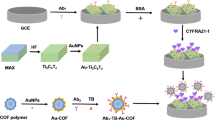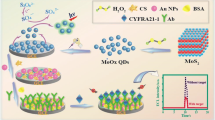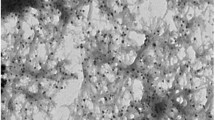Abstract
Prominent electrochemiluminescence (ECL) in Ti-Fe–O nanotube arrays (Ti-Fe–O NTs) with K2S2O8 as the cathode coreactant is reported for the first time. Compared with pure titanium dioxide nanotubes (TiO2 NTs), this heterojunction could effectively reduce the band gap, facilitate electronic transitions, and move the ECL potential to a positive direction. The ECL performance motivated the development of an ultrasensitive ECL immunosensor for detecting cytokeratin fragment 21–1 (CYFRA21-1). Magnetic beads loaded with conductive carbon black (CCB/MNTs) were used to efficiently quench the ECL signal of a Ti-Fe–O NTs electrode and were combined with an ECL immunoassay to realize sensitive detection of CYFRA21-1. Over a CYFRA21-1 concentration range of 1.0 pg·mL−1 ~ 100 ng·mL−1, the change in the ECL signal was highly linear with the logarithm of the CYFRA21-1 concentration, and the limit of detection (LOD) was 0.114 pg·mL−1. This ECL immunosensor was used to successfully determine the CYFRA21-1 content in serum. The recovery of CYFRA21-1 in actual serum was 88.6 – 104.4%, and the RSD was 1.4 – 3.0%. The coreaction solution used in this work was PBS (0.1 M, pH = 7.4) containing 0.05 M K2S2O8, the scanning range was −1.0 – 0 V, the photomultiplier tube (PMT) was set to 750 V, and the scanning rate was 100 mV·s−1.
Graphical abstract






Similar content being viewed by others
References
Bai J, Zhou B-X (2014) Titanium dioxide nanomaterials for sensor applications. Chem Rev 114:10131–10176
Nozik A-J (1983) Photoelectrochemical cells. Nature 414:338–344
Konstantinou I-K, Albanis T-A (2004) TiO2-Assisted photocatalytic degradation of azo dyes in aqueous solution: kinetic and mechanistic investigations: a review. Appl Catal B-Environ 49:1–14
Meng N, Leung M, Leung D, Sumathy K (2007) A review and recent developments in photocatalytic water-splitting using TiO2 for hydrogen production. Renew Sust Energ Rev 11:401–425
Mills A, Hunte S-L (1997) An overview of semiconductor photocatalysis. J Atmos Chem 108:1–35
Oriol R, Sirés I, Brillas E, Andrade A-D (2019) A hybrid photoelectrocatalytic/photoelectro-Fenton treatment of Indigo Carmine in acidic aqueous solution using TiO2 nanotube arrays as photoanode. J Electroanal Chem 847:113088
Yogi C, Kojima K, Takai T, Wada N (2009) Photocatalytic degradation of methylene blue by Au-deposited TiO2 film under UV irradiation. J Mater Sci 44:821–827
Park J-Y, Hwang K-J, Lee J-W, Lee I-H (2011) Fabrication and characterization of electrospun Ag doped TiO2 nanofibers for photocatalytic reaction. J Mater Sci 97:64–66
Yang L, Luo S, Liu R, Cai Q, Xiao Y, Liu S, Su F, Wen L (2010) Fabrication of CdSe nanoparticles sensitized long TiO2 nanotube arrays for photocatalytic degradation of anthracene-9-carbonxylic acid under green monochromatic light. J Phys Chem Lett 114:4783–4789
Guo J, Han Q, Zhong S, Zhu B, Huang W, Zhang S (2018) Au/M-TiO2 nanotube catalysts (M=Ce, Ga Co, Y): preparation, characterization and their catalytic activity for CO oxidation. J Sol-gel Sci Technol 86:699–710
Chen Y, Tang W, Ma J, Ge B, Wang X, Wang Y, Ren P, Liu R (2020) Nickel-decorated TiO2 nanotube arrays as a self-supporting cathode for lithium–sulfur batteries. Front Mater Sci 14:266–274
Qin X, Geng L, Wang Q, Wang Y (2019) Photoelectrochemical aptasensing of ofloxacin based on the use of a TiO2 nanotube array co-sensitized with a nanocomposite prepared from polydopamine and Ag2S nanoparticles. Microchim Acta 186:430
Su Y, Yang S, Liu W, Qiao L, Yan J, Liu Y, Zhang S, Fang Y (2017) Visible light photoelectrochemical sulfide sensor based the use of TiO2 nanotube arrays loaded with Cu2O. Microchim Acta 186:4065–4072
Wang W, Xie Y, Xia C, Du H, Tian F (2014) Titanium dioxide nanotube arrays modified with a nanocomposite of silver nanoparticles and reduced graphene oxide for electrochemical sensing. Microchim Acta 181:1325–1331
Akhavan O, Azimirad R (2009) Photocatalytic property of Fe2O3 nanograin chains coated by TiO2 nanolayer in visible light irradiation. Appl Catal A-Gen 369:77–82
Mei Q, Zhang F, Wang N, Yang Y, Wu R, Wang W (2019) TiO2/Fe2O3 heterostructures with enhanced photocatalytic reduction of Cr (VI) under visible light irradiation. RSC Adv 9:22764–22771
Sadeghi-Niaraki S, Ghasemi B, Habibolahzadeh A, Ghasemi E, Ghahari M (2019) Nanostructured Fe2O3@TiO2 pigments with improved NIR reflectance and photocatalytic ability. Mater Chem Phys 235:121769
Zhang Y-N, Huang W-N, Zhang Y-J, Tang B, Xiao H-S, Zhao G-H (2016) Fabrication and enhanced visible-light photoelectrochemical performance of periodic hierarchical 3D Ti-Fe-O structure. Mater Lett 168:24–27
Lu H-X, Dai G-H, Dai R-H, Ding X, Liu M-C, Sun H-H, Sun C-Q, Zhao G-H (2019) Visible-light-driven photoelectrochemical aptasensor based on reduced graphene oxide/Ti-Fe-O nanotube arrays for highly sensitive and selective determination of microcystin-LR. Electrochim Acta 324:134820
Madian M, Wang Z, Gonzalez-Martinez I, Oswald S, Mikhailova D (2020) Ordered Ti-Fe-O nanotubes as additive-free anodes for lithium ion batteries. Appl Mater Today 20:100676
Gui G, Zhuo Y, Chai Y-Q, Liao N, Zhao M, Han J, Zhu Q, Yuan R, Xiang Y (2013) Supersandwich-type electrochemiluminescenct aptasensor based on Ru(phen)32+ functionalized hollow gold nanoparticles as signal-amplifying tags. Biosens Bioelectron 47:524–529
Ml A, Cw A, Lc A, Dla B (2019) A novel electrochemiluminescence sensor based on resonance energy transfer system between nitrogen doped graphene quantum dots and boron nitride quantum dots for sensitive detection of folic acid. Anal Chim Acta 1090:57–63
Zhai Q-F, Li J, Wang E-K (2017) Recent advances based on nanomaterials as electrochemiluminescence probes for the fabrication of sensors. ChemElectroChem 4:1639–1650
Siegel R-L, Miller K-D, Jemal A (2020) Cancer statistics, 2020. CA Cancer J Clin 70:7–30
Wieskopf B, Demangeat C, Purohit A, Stenger R, Gries P (1995) Cyfra 21–1 as a biologic marker of non-small cell lung cancer: evaluation of sensitivity, specificity, and prognostic role. Chest 108:163–169
Rui H-X, Chang Z-L, Yi L, Wen L-X, Wen B-Y (2015) Optimal cut-off values for CYFRA 21–1 expression in NSCLC patients depend on the presence of benign pulmonary diseases. Clin Chim Acta 440:188–192
Tian C-Y, Xu J-J, Chen H-Y (2012) A novel aptasensor for the detection of adenosine in cancer cells by electrochemiluminescence of nitrogen doped TiO2 nanotubes. Chem Commun 48:8234–8236
Zhang Q, Yu L, Xu C, Zhang W, Diao G (2020) A novel method for facile preparation of recoverable Fe3O4@TiO2 core-shell nanospheres and their advanced photocatalytic application. Chem Phys Lett 761:138073
Dai P, Ke J, Xie C, Wei L, Jin J (2020) An off–on electrochemiluminescence detection for microRNAs based on TiO2 nanotubes sensitized with gold nanoparticles as enhanced emitters. Anal Bioanal Chem 412:5779–5787
Zeng Y, Bao J, Zhao Y-N, Huo D-Q, Chen M (2018) A sensitive label-free electrochemical immunosensor for detection of cytokeratin 19 fragment antigen 21–1 based on 3D graphene with gold nanopaticle modified electrode. Talanta 178:122–128
Wang X, Zhang Y, Zhao L, Zhao D, Wang H, Yang J (2020) Polysaccharide-enhanced ARGET ATRP signal amplification for ultrasensitive fluorescent detection of lung cancer CYFRA 21–1 DNA. Anal Bioanal Chem 412:2413–2421
Wang Y-X, Guo X-Y, Liu J-W, Weng Z-X, Chen Y-X (2018) Development of chemiluminescent microparticle immunoassay for cytokeratin 19 fragment 21–1 content. Chin J Biologic 31:523–527
Yang H, Bao J, Huo D, Zeng Y, Hou C (2020) Au doped poly-thionine and poly-m-Cresol purple: Synthesis and their application in simultaneously electrochemical detection of two lung cancer markers CEA and CYFRA21–1. Talanta 224:121816
Funding
This work was financially supported by the National Natural Science Foundation of China (21778047), and the Natural Science Foundation of Shandong Province (grant no. ZR2021MB024).
Author information
Authors and Affiliations
Corresponding authors
Ethics declarations
Conflict of interest
The authors declare no competing interests.
Additional information
Publisher's note
Springer Nature remains neutral with regard to jurisdictional claims in published maps and institutional affiliations.
Supplementary Information
Below is the link to the electronic supplementary material.
Rights and permissions
About this article
Cite this article
Hua, Q., Tang, F., Wang, X. et al. Electrochemiluminescent determination of CYFRA21-1 serum levels using Ti-Fe–O nanotubes immunoassay. Microchim Acta 189, 136 (2022). https://doi.org/10.1007/s00604-022-05239-z
Received:
Accepted:
Published:
DOI: https://doi.org/10.1007/s00604-022-05239-z




